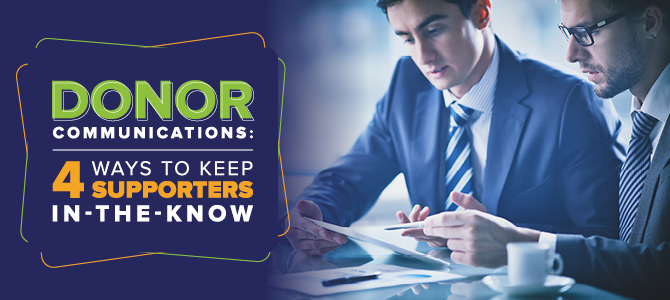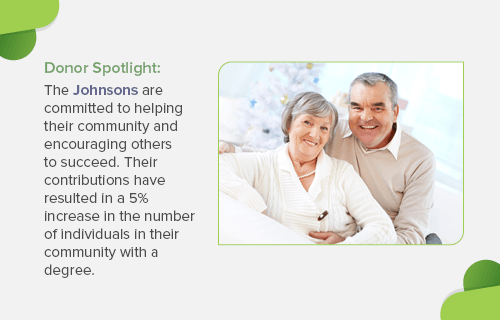
As a fundraising expert, you know that communicating with your donors is important for building relationships and increasing your donation revenue. However, it’s also the area of nonprofit strategic planning where many organizations fall short without even realizing it.
The truth is that, as important as communications are, many nonprofits don’t reach out to their supporters often enough or with high-quality messaging strategies. The reason why is simple.
Fundraisers and nonprofit professionals are completely immersed in the day-to-day of the organization. They know exactly what’s going on. However, donors don’t have that inside look at the activities of the organization. And fundraisers fail to provide enough of this insight to the supporters because they don’t realize how important the additional context really is. Plus, it doesn’t help that many nonprofit professionals also fail to effectively leverage their data to make their messages as effective as possible.
This dangerous combination of overlooked aspects of your communication strategies can culminate into a strategy that fails to promote the development of healthy relationships with supporters.
However, by implementing a few key strategies and best practices, your nonprofit can avoid this pitfall and develop an approach that will promote donor retention and organizational growth.
So what are these strategies? That’s what we’ll be covering throughout this article. The best practices that we’ll explore here include:
- Creating smart donor segments in your CRM.
- Personalizing content as much as possible.
- Using multiple communication channels for outreach.
- Showing ample appreciation for donors.
Ready to learn more? Let’s jump in.

1. Create smart donor segments in your CRM.
Your donor database is a hub of important information about your organization’s supporters. It’s where you can store their contact information, personal details, fundraising history, and other valuable data.
One of the most helpful functions of your nonprofit CRM is segmentation. Bloomerang’s donor database guide explains that segmentation is the key to creating personalized communications.
Segmentation is especially useful because it allows you to include personal details or interests in messages to each supporter in an efficient way. For instance, if you work with an animal shelter nonprofit, you might create a segment of cat lovers in your donor database and another of dog lovers. This way, you can send the latest information about dog adoption events to all of your dog lovers and information about cat adoption events to cat lovers.
Each segment of supporters gets a more personalized message, specifically targeted to their interests. However, your organization doesn’t need to use limited resources and manpower to write a different message to each and every individual who might be interested in attending an event. It’s a win-win for everyone!
Some of the other segments that you might choose to employ for your nonprofit’s communication strategy may include:
- Reasons for giving. If you know why a supporter donates to your cause, you can guide your fundraising asks accordingly. For instance, if you have a wide service offering, such as an environmental cause, and you know that some supporters are passionate about marine life, versus deforestation, versus clean drinking water, you can tell stories that match those interests. You may talk to a donor who had a loved one impacted by the particular disease you are working to eradicate, versus someone who was moved by an advertisement but has no direct connection to your cause.
- Giving frequency and recency. One way to show donors you are paying attention to the contributions they are making is to acknowledge frequency and recency of giving, even for those who haven’t given in awhile. This strategy will also prevent you from alienating your best supporters: monthly donors. Monthly donors should always have their commitment acknowledged prior being solicited for additional gifts. This will also work to your advantage if you make emergency appeals to recent donors. Your appeal may start off by saying “We know you’ve given recently (thank you!) but we have a new urgent need.”
- Average giving level. You probably wouldn’t direct a major supporter to a crowdfunding campaign or talk to a low-level supporter during the quiet phase of a capital campaign. Creating segments based on giving level allows you to customize your communication to reach the most appropriate supporter with the message that’s most relevant to them.
- Engagement level. Chances are, some of your supporters are much more engaged with aspects of your strategy than others. This is only natural! Segmenting supporters by engagement level allows you to reach supporters with relevant messages. For instance, if you notice someone dropped from a highly-engaged status to a less-engaged one, you might reach out to them with a “We miss you!” message.
Each of these segments can be used for very specific outreach to create a more personalized message for the reader. This increases the chances they’ll read your messages and stay engaged with your organization’s many opportunities.

2. Personalize content as much as possible.
We discussed in the previous section how segmentation helps you take the first step toward communication personalization. However, it’s not the end-all-be-all solution. Your organization also needs to add personal details to messages so that supporters know that you’re talking directly to them rather than sending a mass message.
While your supporters understand that they’re not your only correspondent, they still want to know that your messages are directed for them rather than for your supporters at large. Studies have shown that 72% of consumers only engage with messages specifically targeted to their interests. And, as we know, awesome engagement and stewardship strategies are what keep supporters coming back again and again.
As you analyze your marketing toolkit, be sure you have automation opportunities so that your nonprofit can automatically include personal details about supporters in messages. For instance, you should be sure you have the ability to include each supporter’s:
- Preferred name
- Donation information
- Campaign contributed to
- Geographic location
- Specific interests
Integrations are especially useful for this automation strategy. For instance, if your donor database integrates with popular email marketing tools like Mailchimp, you’ll find that you can automatically pull data from your CRM into your message. The result will look something like this:
Dear [supporter’s name],
Thank you so much for your donation of [amount donated] for the [name of campaign]. Your donation helped the campaign provide 600 backpacks full of school supplies to students at [local school name].
Thank you for your generosity!
[Name of nonprofit organization]
With the right tools, information for each of these brackets will be automatically filled to reflect the information stored in your CRM about the supporter’s contribution.
If you’re sending something through the mail, be sure to add a handwritten note or signature, just to show that you spent some time on the piece before shoving it in an envelope.

3. Use multiple communication channels for outreach.
Research shows that multi-channel outreach campaigns are the most effective. This is because you reach your supporter at multiple “touch points” when you employ this strategy. According to this guide, it takes between 7 and 12 “touches” before you’re able to convince a supporter to take action.
Consider, for instance, that you’re a supporter of a local animal shelter. The shelter is hosting an adoption event. Would you be more likely to pay attention to 10 emails that are sent about the event? Or 4 emails, 3 social posts, 1 direct mail letter, and 2 texts? Chances are, if you receive email after email about the same subject, you’re more likely to stop engaging. However, changing up the platform maintains engagement and further encourages involvement.
Keep in mind that each method of communication should lead your supporters to take action. For instance, if you’re funneling supporters to your online donation page, you should include a link to the page directly from your emails and social posts, make sure your page is mobile-optimized before including the link in texts, and share the URL on direct mail. According to this Accudata guide, this interconnectivity between your outreach channels is a key aspect of an effective digital marketing strategy.
Be sure to consider the platforms your supporters tend to respond most positively to before crafting your strategy and conducting outreach. Some of the channels you might consider include:
- Direct mail
- Social media
- Physical flyers
- Texts
- Mobile app notifications
- Social direct messages
Don’t simply copy and paste the same message for each platform. Be sure to customize the message for the platform on which it will be presented, varying elements such as message length, tone, and imagery.
However, don’t miss out on any important message elements as you conduct this customization! We recommend consulting effective fundraising letter templates, analyzing the content included there, and customizing your messages to include those elements (although they will differ from the original template).
For instance, if you’re hosting an upcoming event, you’ll need to include information about the day and time that the event will occur, the location (or virtual location) of the event, and how the supporter can register or volunteer. Include these details on every message you send out promoting the event opportunities, although you may present them differently depending on the platform used.

4. Show ample appreciation for donors.
When supporters do get involved with your many engagement opportunities, you should be sure to show them how much you appreciate their contributions. A thank-you confirmation email directly after contributions or registrations is a great start, but we recommend taking your appreciation a step further.
When it comes to appreciation, remember that the little things can mean a lot. A hand-written thank-you card adds a level of personalization to your communication that shows supporters that you’re willing to go the extra mile to show them that you care. Or, creating a thank-you video after a campaign to post on your social media platforms gives supporters the opportunity to actively like the communication strategy.
Some other strategies you may employ include:
- Shout out to supporters. Give a shout out to your supporters who have made a big impact on your campaigns using social media, newsletters, or annual reports. For instance, this guide shows an example of a shout out made to The Johnsons that thanks them for their involvement with the organization:

- Provide trinkets to supporters. Little trinkets like a sticker or picture from your nonprofit provide a small reward for a supporter’s involvement. This shows them that you care and makes the supporter feel even better about their involvement with your mission.
- Host (virtual) appreciation events. Host a virtual event allowing supporters to get “together” and discuss your mission with others who hold your mission close to their hearts. This gives you the chance to provide a unique experience to these individuals and to say “thank you” over a live streaming service.
Especially in the age of COVID-19, it’s more important than ever to show supporters that you appreciate their continued dedication to your nonprofit. Their regular day-to-day activities and schedules were disrupted by the virus just like yours was. Their continued involvement shows their dedication to your mission, which is something that deserves a million thank-yous.
Donor communication is a key aspect of your fundraising and engagement strategies. Therefore, effectively crafting your communications is necessary for sustainable practices and organizational growth. These four tips are a great starting point to maximize your donor communication strategy. Good luck!
About the Author
 Jay Love is Co-Founder and current Chief Relationship Officer at Bloomerang. He has served this sector for 33 years and is considered the most well-known senior statesman whose advice is sought constantly.
Jay Love is Co-Founder and current Chief Relationship Officer at Bloomerang. He has served this sector for 33 years and is considered the most well-known senior statesman whose advice is sought constantly.
Prior to Bloomerang, he was the CEO and Co-Founder of eTapestry for 11 years, which at the time was the leading SaaS technology company serving the charity sector. Jay and his team grew the company to more than 10,000 nonprofit clients, charting a decade of record growth.
He is a graduate of Butler University with a B.S. in Business Administration. Over the years, he has given more than 2,500 speeches around the world for the charity sector and is often the voice of new technology for fundraisers.


Add Comment